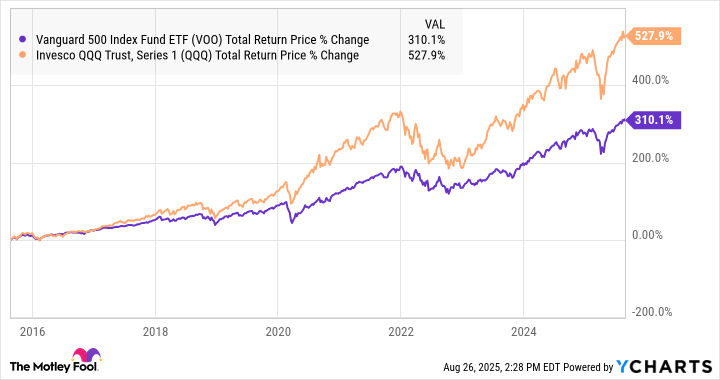
Over the past decade, the S&P 500 Index has demonstrated an extraordinary capacity for wealth generation. An initial investment of $1,000 in the Vanguard S&P 500 ETF (VOO), assuming dividend reinvestment, would have grown to approximately $4,100 as of today-an annualized return of 15%. While such figures are compelling, they merit closer examination through the lens of capital allocation and market dynamics.
Underlying Drivers of the S&P 500’s Performance
To understand this remarkable trajectory, one must consider both macroeconomic tailwinds and sector-specific contributions. The index had already rebounded significantly from its 2009 financial crisis lows by the start of the decade in question. Achieving a total return of 310% on top of that recovery underscores the resilience and adaptability of the U.S. equity markets.

A granular analysis reveals that technology-driven large-cap equities have disproportionately influenced these gains. The emergence of trillion-dollar megacap tech companies-once a rarity but now numbering eight-has redefined the landscape of valuation multiples and earnings growth. Below is a comparative overview of the five largest holdings within the Vanguard S&P 500 ETF and their respective performances over the past decade:
| Company (Symbol) | % of S&P 500 | 10-Year Total Return |
|---|---|---|
| Nvidia | 8.1% | 32,230% |
| Microsoft | 7.4% | 1,270% |
| Apple | 5.8% | 843% |
| Amazon | 4.1% | 802% |
| Alphabet | 3.7% | 566% |
| S&P 500 | 100% | 310% |
Notably, even the least performant among these megacap stocks surpassed the broader index by a significant margin. This divergence raises questions about concentration risk and the sustainability of such outsized returns.
Forward-Looking Considerations
While historical performance provides valuable context, it is imperative to approach future projections with caution. Historically, the S&P 500 has delivered annualized returns in the range of 9% to 10% over extended periods. Against this backdrop, the current decade’s 15% annualized return appears anomalous and contingent upon specific conditions unlikely to persist indefinitely.
- Valuation Multiples: Elevated price-to-earnings ratios across key constituents suggest potential downside risks should earnings growth decelerate.
- Regulatory Headwinds: Increased scrutiny of monopolistic practices among leading tech firms could impact profitability margins.
- Market Dynamics: Shifts in consumer behavior or technological innovation may alter the competitive landscape, favoring new entrants.
In conclusion, while the S&P 500’s recent performance offers a compelling narrative, prudent investors must remain vigilant. Future returns will likely hinge on a confluence of factors, including regulatory developments, geopolitical stability, and corporate governance practices. As always, diversification remains paramount in navigating uncertain waters. 🌊
Read More
- Deepfake Drama Alert: Crypto’s New Nemesis Is Your AI Twin! 🧠💸
- Can the Stock Market Defy Logic and Achieve a Third Consecutive 20% Gain?
- Dogecoin’s Big Yawn: Musk’s X Money Launch Leaves Market Unimpressed 🐕💸
- Bitcoin’s Ballet: Will the Bull Pirouette or Stumble? 💃🐂
- SentinelOne’s Sisyphean Siege: A Study in Cybersecurity Hubris
- Binance’s $5M Bounty: Snitch or Be Scammed! 😈💰
- LINK’s Tumble: A Tale of Woe, Wraiths, and Wrapped Assets 🌉💸
- ‘Wake Up Dead Man: A Knives Out Mystery’ Is on Top of Netflix’s Most-Watched Movies of the Week List
- Yearn Finance’s Fourth DeFi Disaster: When Will the Drama End? 💥
- Ethereum’s Fusaka: A Leap into the Abyss of Scaling!
2025-09-06 17:33